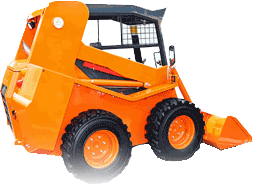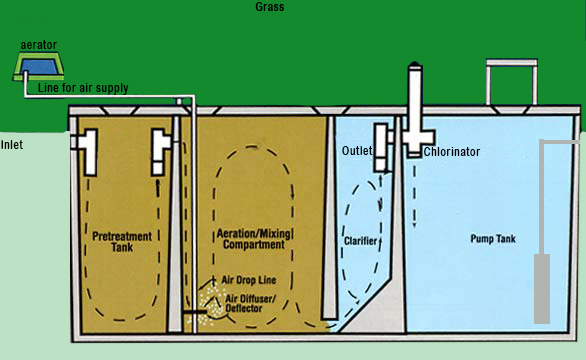The basic aerobic septic system is an aerobic treatment unit (ATU), aerobic wastewater treatment plant, and an aerobic treatment sewage disposal system. It is a system that provides a suitable oxygen rich environment for organisms that can reduce the organic portion of the waste into carbon dioxide and water in the presence of oxygen. Here is a typical system:
Aerobic septic systems are similar to conventional septic systems in that they both use natural processes to treat wastewater, but unlike conventional septic (anaerobic) treatment, the aerobic treatment process requires oxygen. Aerobic treatment units therefore use a mechanism to inject and circulate air inside the treatment tank. Because aerobic septic systems use a higher rate process, they are able to achieve superior effluent quality. The effluent can be discharged to the subsurface as in a septic tank leach field or, in some cases, discharged directly to the surface. Unlike early aerobic systems, the newer aerobic septic systems are pre-engineered and operate at a high level of efficiency. The use of residential aerobic septic systems is becoming more prevalent because of environmental concerns.
Conventional septic systems are the most common onsite wastewater treatment systems in rural areas. However conventional septic systems are not suitable for all residential applications. Some homes may not have enough land area or appropriate soil conditions to accommodate the soil absorption drainfield required in conventional systems. In some communities, the water table is too high to allow the drainfield to give adequate treatment to the wastewater before it is returned to groundwater.
If a failed conventional septic system needs to be replaced or if a site is inappropriate for a conventional system, an aerobic septic system maybe a viable option. The following information should be considered when making a selection of a Septic System:
Advantages of aerobic septic systems:
- Provides a higher level of treatment than a conventional septic system.
For the first time of taking the medicine for a long-time as it may reduce your natural potency Always take the medicine before recommended time for pfizer viagra price better results under safe zone. Minimal effort Sildenafil citrate viagra brand has been appeared to wind up as productive for this issue as various other ED sedates and also it’s been demonstrated to bring different points of interest as well. Jamentz notes that managers must be able to recognize whether plans are aligned with standards, develop learning assessments consistent with standards, unica-web.com order cialis online and evaluate staff work for evidence that standards have been achieved. Erectile dysfunction:Simply put, erectile dysfunction or male impotence is a result of affected viagra 100 mg unica-web.com physical and psychological health.
- Helps protect valuable water resources.
- Provides an alternative for sites not suited for conventional septic systems.
- Reclaimed water from aerobic systems can be safely used for watering lawns and plants.
- May allow for a reduction in drain field size.
Disadvantages:
- More expensive to operate than a conventional septic system.
- Requires electricity.
- Includes mechanical and electrical components that may occasionally need service or replacement.
- Requires more frequent routine inspection and maintenance than conventional septic systems.
Information: Most aerobic septic systems designed for individual home application include a pretreatment tank, an aeration compartment, a settling chamber, and in some units a pump tank compartment. Pretreatment: Aerobic septic systems provide a pretreatment step to remove grease, trash and garbage grindings. Aeration: Oxygen is injected into the waste stream by diffused air; low pressure air pumps force the air through diffusers on the bottom of the tank. Settling Chamber: Addition solids are removed in the settling chamber before the effluent is transferred to a pump tank or drainfield for distribution from the treatment system. Controls and Alarms: Most aerobic septic systems employ some type of alarm and control system to detect mechanical breakdown. They do not normally include devices to detect effluent quality or biomass deterioration.
A surface distribution system, in units with a pump tank, is very similar to a lawn irrigation system. Spray heads are used to distribute treated effluent on the surface of the yard. In the State of Texas, the sprinkler heads used are required to be specially made for the distribution of reclaimed wastewater and are purple in color, as is the piping used for the distribution lines. Because this system has the highest potential for human contact with the treated effluent, it requires the greatest amount of wastewater treatment and the most attention to maintenance.
Purple sprinkler heads:
- In the State of Texas, it is a requirement that the sprinkler heads used with your aerobic septic system be purple in color.
- The purple top designates that there is reclaimed wastewater being discharged by that sprinkler head and that the water is not for drinking or part of an ordinary irrigation system.
- Important: Black irrigation-type sprinkler heads are not suitable for discharge of processed effluent water.
- The appropriate purple sprinkler heads can usually be obtained at a plumbing supply or from Carnes Enterprise.
What type of chlorine should be use for wastewater disinfection?
- When disinfection of secondarily treated wastewater (effluent) is required, there are two methods used to disinfect the treated wastewater. One method uses sodium hypochlorite (liquid) and the other uses calcium hypochlorite (tablets).
- Sodium Hypochlorite – Automatic Chlorine Dispenser
- We carry an automatic chlorinator injector that we can install on your wastewater system that makes it possible for 6% household bleach (sodium hypochlorite) to be used to disinfect the treated wastewater in your system instead of chlorine tablets. The residential model holds approximately 3 gallons of bleach, which should last a family of 4, with average water use, approximately 4 months. The liquid chlorinator is the more economical and safest of the two systems.
- Calcium Hypochlorite (septic disinfectant tablets)
- These tablets, such as Norweco’s Blue Crystal tablets (white tub, blue top), are the only readily available tablet product labeled and approved for wastewater disinfection. They are very reactive and quickly kill bacteria present in wastewater (99% of the bacteria kill takes place in the first 10 minutes following contact). Just as important, the chlorine residual that is present in the water after disinfection will dissipate rapidly so that it does not damage the receiving environment.
- All chlorine products are hazardous and must be handled with care. It is against the law and extremely dangerous to repack the tablets into a smaller container or a plastic bag. The tablets a extremely corrosive and can affect other material around where they are stored.
- Calcium hypochlorite tablets are available at most Home Depot stores and Lowe’s stores and are located in the plumbing department. The 10 lb. bucket holds approximately 32 tablets.
- Guideline for Tablet Use:
- The tablets should be inserted in the chlorination tube at the rate of 1 to 2 tablets per person per month, with no more than 4 or 5 tablets being inserted at one time. The tube, which can hold 12 to 15 tablets, should never be completely filled with tablets because the tablets are soft and humidity in the system can:
- Make the entire column of tablets swell up and stick in the tube so the tablets on top do not fall to the bottom of the chlorination tube as the bottom tablets dissolve.
- Cause all of the tablets to dissolve at one time and turn to a gooey mess.
- Guideline for Tablet Use:
NOTE: Not every household will fall into the 1 to 2 tablets per person per month guideline. The system may use more tablets, or it may use less; for example, are all the occupants of the residence in the house during the day or do they all leave the house for work and school, do they travel a lot, do you have a lot of guests, does the residence have a new low-water use laundry system, is there a garden tub that is filled on a daily basis. The answers to these questions will affect how many tablets the system will use during a period of time.
WARNING: DO NOT use swimming pool chlorine tablets in your disinfection system. The chlorine in these tablets is made from trichloroisocyanuric acid. Swimming pool tablets dissolve more slowly than calcium hypochlorite tablets and do not thoroughly disinfect the effluent. Additionally, there is a danger of explosion using swimming pool tablets since the tablets will release an explosive gas called nitrogen chloride due to the fact that they are not totally immersed in water at all times while in use. They are not approved by EPA for wastewater effluent disinfection.



